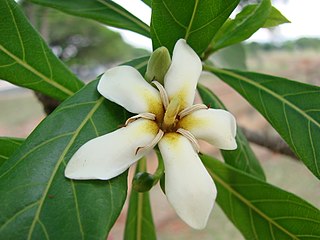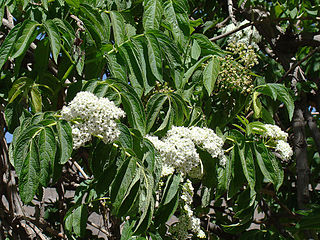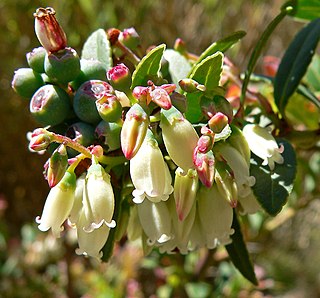
Genipa americana is a species of trees in the family Rubiaceae. It is native to the tropical forests of North and South America, as well as the Caribbean.

Bactris gasipaes is a species of palm native to the tropical forests of Central and South America. It is well spread in these regions, where it is often cultivated by smallholders in agroforestry systems or more rarely, in monoculture. Common names include peach palm in English, among others used in South American countries. It is a long-lived perennial plant that is productive for 50 to 75 years on average. Its population has an important genetic diversity, leading to numerous fruits, colors, and qualities. The fruits are edible and nutritious but need to be cooked for 30 minutes to five hours. They also benefit many animals in the wild. Peach-palms are also cultivated for the heart of palm, and the trunk can make valuable timber.

Spondias purpura is a species of flowering plant in the cashew family, Anacardiaceae, that is native to tropical regions of the Americas, from Mexico to northern Colombia and the southwest Caribbean Islands. It has also been introduced to and naturalized to other parts of the American tropics, Southeast Asia, and West Africa. It is commonly known as jocote, which derives from the Nahuatl word xocotl, meaning any kind of sour or acidic fruit. Other common names include red mombin, Spanish plum, purple mombin, Jamaica plum, and hog plum.

Peltogyne, commonly known as purpleheart, violet wood, amaranth and other local names is a genus of 23 species of flowering plants in the family Fabaceae; native to tropical rainforests of Central and South America; from Guerrero, Mexico, through Central America, and as far as south-eastern Brazil.

Muntingia is a genus of plants in the family Muntingiaceae, comprising only one species, Muntingia calabura, and was named in honour of Abraham Munting. It is native to the Neotropics, from Mexico south to Bolivia and Argentina, with edible fruit, and has been widely introduced in other tropical areas.

Astrocaryum alatum is a species of palm with edible nuts, a flowering plant in the family Arecaceae. It is a common species found many types of rainforests and swamps in Honduras, Costa Rica, Nicaragua and Panama.

Hedyosmum mexicanum is a species of plant in the family Chloranthaceae. It is found in Guatemala and Mexico. It is threatened by habitat loss.

Renealmia is a plant genus in the family Zingiberaceae. Its members are native to tropical Africa and tropical America. In Peru, fruits and tubers are sources of indigenous dyes. and indigenous medical treatments for leishmania and malaria In Colombia, it is used to treat snakebite. Bracts and leaves can serve as phytotelmata, retaining small quantities of water that offer habitat for other organisms.

Sambucus peruviana is a species of tree in the family Adoxaceae. It is native to Central America and South America.

The Isthmian–Atlantic moist forests (NT0129) are a Central American tropical moist broadleaf forest ecoregion located on the lowland slopes on the caribbean sea side of Nicaragua and Costa Rica and the Gulf and Pacific Ocean sides of Panama. The forest species are a mix of North American and South American, as this region only became a land bridge in the past 3 million years.
Magnolia poasana is a sub-tropical to tropical, subcanopy tree, growing in areas of montane rainforest. The names "Poas", and "poasana" originate from the Poás Volcano in Costa Rica where, along with Panama, they grow in the wild. First described by Henri François Pittier in 1910, it was later described and included in Magnolia by James Edgar Dandy (1927).

Guazuma ulmifolia, commonly known as West Indian elm or bay cedar, is a medium-sized tree normally found in pastures and disturbed forests. This flowering plant from the family Malvaceae grows up to 30m in height and 30–40cm in diameter. It is widely found in areas such as the Caribbean, South America, Central America and Mexico serving several uses that vary from its value in carpentry to its utility in medicine.

Pentaclethra macroloba is a large and common leguminous tree in the genus Pentaclethra native to the wet tropical areas of the northern Neotropics, which can form monocultural stands in some seasonally flooded habitats. It has giant, bipinnate leaves shaped like feathers. It uses seed dispersal by water to establish itself in new areas, having floating seeds that are left behind after the waters recede after floods or tides. It has hard timber which is not very resistant to rot in the tropics, but it can be treated, has a pretty pink-red colour when dry, and has a number of uses. Oil used in cosmetics is extracted from the large seeds. In the northern Amazon region the bark is used in herbal medicine as an antivenom, and in the Guianas the bark has been used as a fish poison. Despite their toxicity, the seeds are eaten by variegated squirrels, parrots and macaws, and serve as the nurseries of the larvae of the moth Carmenta surinamensis.

Lecythis ampla is a species of woody plant in the family Lecythidaceae, which also includes the Brazil nut. Common names include coco, olla de mono, jicaro and salero. It is found in Central and South America. It has been considered an endangered species in Costa Rica.

Vaccinium consanguineum or Costa Rican blueberry is a species of Vaccinium found in the montane forests of southern Mexico, Honduras, Costa Rica, and Panama at altitudes of 2100-3100 meters AMSL. In Costa Rica it is found in the Talamanca mountain range and the Central Volcanic mountain range.

Peltogyne mexicana is a species of tree that belongs to the family Fabaceae. Members of the genus Peltogyne are commonly known in different regions as purpleheart, morao, nazareno, violeta, pau roxo, or palo morado. The genus Peltogyne is neotropical and is made up of 23 species. Peltogyne mexicana occurs in Guerrero, Mexico, and is one of the northernmost species in the genus.

Parkia pendula is a species of neotropical evergreen tree found throughout Central and South America. It is part of the Parkia genus, a group of flowering plants that are part of the legume family, Fabaceae.
Goethalsia is a monotypic genus of flowering plants belonging to the family Malvaceae. It only contains one species, Goethalsia meiantha(Donn.Sm.) Burret It is within the Grewioideae tribe.
Inga oerstediana is a species of tree in the family Fabaceae. It was described by English botanist George Bentham. It can be found in Mexico, Belize, El Salvador, Honduras, Nicaragua, Costa Rica, Panama, Colombia, Venezuela, Ecuador, Peru, Bolivia, Brazil and Trinidad and Tobago.

Sciodaphyllum pittieri is a species of flowering plant in genus Sciodaphyllum. It is native to the mountain forests of Costa Rica and western Panama.

















